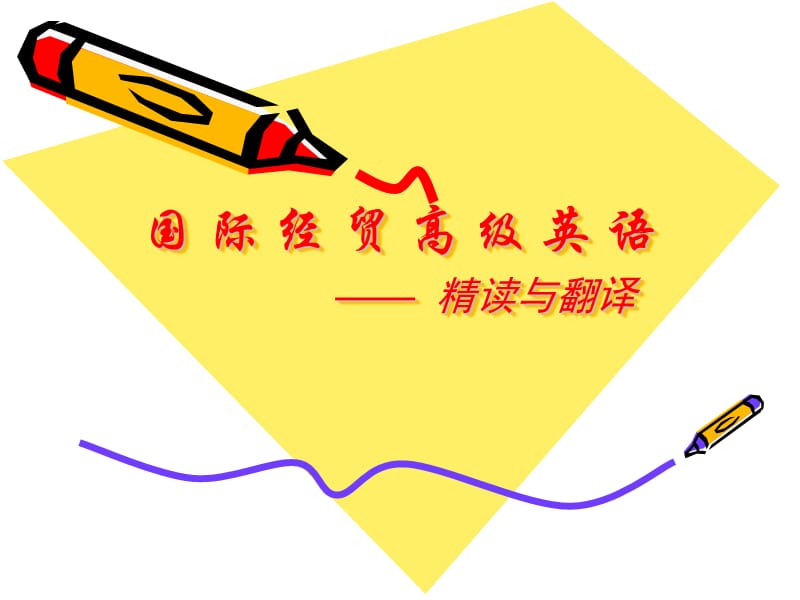《國(guó)際經(jīng)貿(mào)高級(jí)英語(yǔ)-精讀與翻譯ppt.ppt》由會(huì)員分享�����,可在線閱讀�����,更多相關(guān)《國(guó)際經(jīng)貿(mào)高級(jí)英語(yǔ)-精讀與翻譯ppt.ppt(26頁(yè)珍藏版)》請(qǐng)?jiān)谘b配圖網(wǎng)上搜索�����。
1�����、國(guó) 際 經(jīng) 貿(mào) 高 級(jí) 英 語(yǔ) 精讀與翻譯,內(nèi)容提要,本書是國(guó)際經(jīng)濟(jì)學(xué)和國(guó)際貿(mào)易學(xué)專業(yè)英語(yǔ)精讀與翻譯教材�����。全書共有課文20篇�����,主要選自美、英等國(guó)出版的最新經(jīng)濟(jì)學(xué)專著和刊物原文素材�����,內(nèi)容極為豐富�����,涉及一般經(jīng)濟(jì)學(xué)理論�����、國(guó)際金融�����、國(guó)際貿(mào)易�����、國(guó)際投資�����、企業(yè)管理�����、中國(guó)經(jīng)濟(jì)改革�����、中外經(jīng)濟(jì)關(guān)系等經(jīng)貿(mào)領(lǐng)域�����。同時(shí)�����,本書結(jié)合課文還配有詞組(包括專有名詞)的解釋�����,短語(yǔ)�����、句子和段落的中譯英�����,以培養(yǎng)學(xué)生的閱讀和翻譯能力。頗具特色的是:本書配套了專業(yè)英語(yǔ)的寫作訓(xùn)練�����,以提高學(xué)習(xí)者的英語(yǔ)寫作能力�����;本書在每篇課文后還配了補(bǔ)充閱讀材料�����,它們與課文有很大的相關(guān)性�����,拓展了讀者的閱讀面和理解深度�����。本書內(nèi)容新穎�����、選材精當(dāng)、編排合理
2�����、�����、重點(diǎn)突出�����,既可作為高等學(xué)校經(jīng)濟(jì)�����、貿(mào)易�����、金融�����、管理等學(xué)科的專業(yè)英語(yǔ)教材�����,或作為任何涉外經(jīng)濟(jì)工作者的英語(yǔ)自學(xué)課本�����,也可以作為準(zhǔn)備和參加博士生專業(yè)英語(yǔ)(經(jīng)管類)考試的參考讀物�����。,Unit OneKnowledge and Economic Growth,TEXT Starting as low-income economies in the 1960s, a few economies in East Asia managed, in a few decades, to bridge all or nearly all of the income gap that separated th
3�����、em from the high-income economies of the Organisation for Economic Co-operation and Development (OECD). Meanwhile many other developing economies stagnated.,Unit OneKnowledge and Economic Growth,What made the difference? One way to grow is by developing hitherto unexploited land. Another is to accum
4�����、ulate physical capital: roads, factories, telephone networks. A third is to expand the labor force and increase its education and training. But Hong Kong (China) and Singapore had almost no land. They did invest heavily in physical capital and in educating their populations, but so did many other ec
5�����、onomies. During the 1960s through the 1980s the Soviet Union accumulated more capital as a share of its gross domestic product (GDP) than did Hong Kong (China), the Republic of Korea, Singapore, or Taiwan (China). And it increased the education of its population in no trivial measure. Yet the Soviet
6�����、s generated far smaller increases in living standards during that period than did these four East Asian economies.,Unit OneKnowledge and Economic Growth,Perhaps the difference was that the East Asian economies did not build, work, and grow harder so much as they built, worked, and grew smarter. Coul
7、d knowledge, then, have been behind East Asias surge? If so, the implications are enormous, for that would mean that knowledge is the key to developmentthat knowledge is development. How important was knowledge for East Asias growth spurt? This turned out not to be an easy question to answer. The
8�����、 many varieties of knowledge combine with its limited marketability to present a formidable challenge to anyone seeking to evaluate the effect of knowledge on economic growth.,Unit OneKnowledge and Economic Growth,How, after all, does one put a price tag on and add up the various types of knowledge?
9�����、 What common denominator lets us sum the knowledge that firms use in their production processes; the knowledge that policymaking institutions use to formulate, monitor, and evaluate policies; the knowledge that people use in their economic transactions and social interactions? What is the contributi
10�����、on of books and journals, of R translate into),The development of new economic theories has raised many subjects to statistics. For example, high rates of school enrollment may not translate into high rates of economic growth if the quality of education is poor, or if educated people are not employe
11�����、d at their potential because of distortion in the labor market.,Unit OneKnowledge and Economic Growth,4. 1994年�����,在經(jīng)過長(zhǎng)期研究之后�����,著名經(jīng)濟(jì)學(xué)家克魯格曼發(fā)表了一份對(duì)多國(guó)技術(shù)進(jìn)步情況調(diào)查的報(bào)告�����。他指出�����,亞洲的經(jīng)濟(jì)不是建立在技術(shù)進(jìn)步的基礎(chǔ)上�����,所以含有很多泡沫�����。3年后爆發(fā)的東南亞經(jīng)濟(jì)危機(jī)證實(shí)了他的猜想�����。(variations in technical progress),In 1994, after a long period of research, the famous econom
12�����、ist Krugman presented a study report analyzing variations in technical progress across a large number of countries. He said in the report that the economic development of Asia was not based on the progress of technology, so the economy contained much foam. Three years later, the sudden break-out of
13�����、Southeast Asian economic crisis verified his aasumption.,Unit OneKnowledge and Economic Growth,5. 由于科學(xué)技術(shù)在一定程度上是無形的,所以�����,到目前為止�����,人們還未想出確定其價(jià)值大小的理想方法�����。(put a value on),People havent hitherto come up with an ideal method to put a value on science and technology, for it is intangible to some degree.,Unit On
14�����、eKnowledge and Economic Growth,III. Put the following passage into English:,在信息時(shí)代�����,競(jìng)爭(zhēng)力的關(guān)鍵是知識(shí)�����,而不是實(shí)物資產(chǎn)或資源�����。不僅對(duì)知識(shí)密集型部門�����,比如電腦軟件或生物技術(shù)部門來說是如此�����,而且對(duì)工業(yè)時(shí)代的制造業(yè)公司或公共事業(yè)公司來說也是這樣�����。 對(duì)知識(shí)密集型的部門來說�����,來源于研究與開發(fā)的�����、應(yīng)用在革新產(chǎn)品和工藝上的知識(shí)是至關(guān)重要的因素�����。但是,對(duì)工業(yè)時(shí)代的制造業(yè)公司或公用事業(yè)公司來說�����,利用有關(guān)客戶的知識(shí)來改善服務(wù)才是重要的�����。,Unit OneKnowledge and Economic Growth,In the i
15�����、nformation age, knowledge, rather than physical assets or resources, is the key to competitiveness. This is as true for the knowledge-intensive industries, such as software or biotechnology, as it is for industrial age manufacturing companies or utilities. For the knowledge-intensive sectors, kno
16�����、wledge which feeds through from research and development to innovative products and processes is the critical element. But with industrial age manufacturing companies or utilities, using knowledge about customers to improve service is what counts.,Unit OneKnowledge and Economic Growth,今天�����,關(guān)于對(duì)知識(shí)態(tài)度的新情況
17�����、是�����,人們認(rèn)識(shí)到�����,需要像對(duì)待其他任何資產(chǎn)一樣�����,駕馭�����、管理和使用它�����。這個(gè)問題不僅涉及到什么是適當(dāng)?shù)倪^程和系統(tǒng)�����,而且涉及如何把知識(shí)計(jì)入資產(chǎn)負(fù)債表�����。 今后,知識(shí)資本的價(jià)值將得到更加普遍的衡量和報(bào)告�����。對(duì)與知識(shí)資本有關(guān)的重要績(jī)效指標(biāo)的衡量和報(bào)告將成為大組織的一項(xiàng)較為普遍的做法�����,這對(duì)財(cái)務(wù)賬戶將是一個(gè)補(bǔ)充�����。,Unit OneKnowledge and Economic Growth,What is new about attitudes to knowledge today is the recognition of the need to harness, manage and use it like
18�����、 any other asset. This raises issues not only of appropriate processes and systems, but also of how to account for knowledge in the balance sheet. In future, the value of intellectual capital will be more widely measured and reported. The measurement and reporting of key performance indicators related to intellectual capital will become a more widespread practice among major organizations, completing the financial accounts.,
 國(guó)際經(jīng)貿(mào)高級(jí)英語(yǔ)-精讀與翻譯ppt.ppt
國(guó)際經(jīng)貿(mào)高級(jí)英語(yǔ)-精讀與翻譯ppt.ppt

